Art World
‘This Is the Biggest Challenge We’ve Faced Since the War’: How the Coronavirus Crisis Is Exposing the Precarious Position of Museums Worldwide
As museums lose money amid indefinite closures, points of weakness are starting to appear.
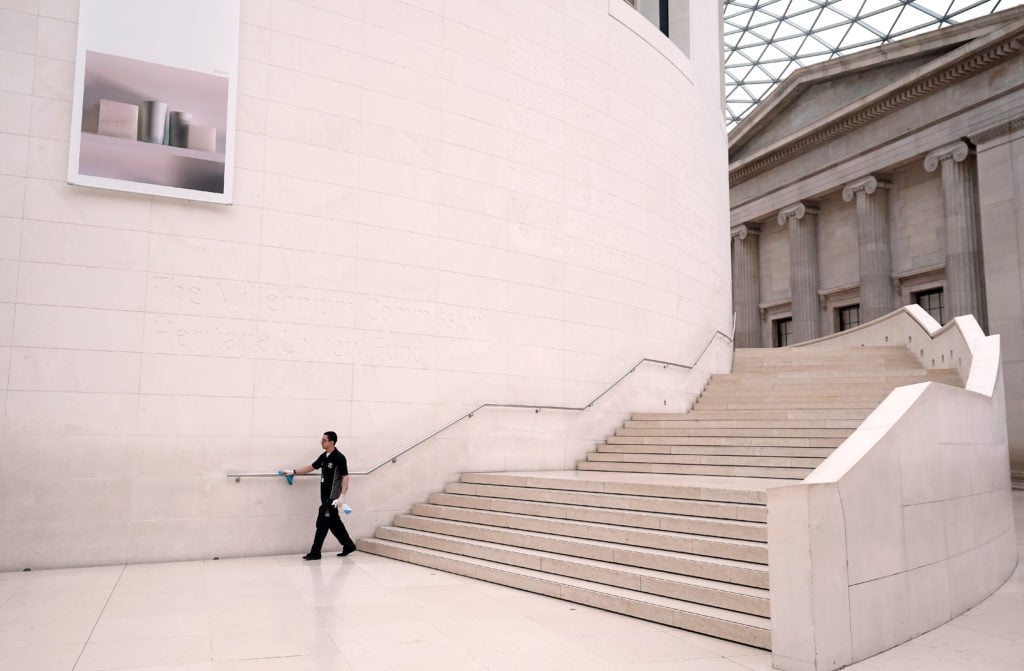
As museums lose money amid indefinite closures, points of weakness are starting to appear.

by
Julia Halperin &
Javier Pes

The Metropolitan Museum of Art sent shockwaves through the museum world last week when it revealed that it expected to lose as much as $100 million and remain closed until July as part of a global effort to fight coronavirus. Layoffs, its leadership suggested, were likely.
Many administrators at other museums immediately wondered: if an institution as wealthy as the Met, which has an endowment of more than $3 billion, will struggle to survive the pandemic without drastic measures, what hope is there for the rest of us?
The global health crisis has thrown an uncomfortable spotlight on the precariousness of the museum sector, which operated on relatively tight budgets even before COVID-19 hit. Now, institutions are being faced with incredibly difficult questions about how long they can afford to pay their staff before layoffs, about which programs to cut and which ones to keep, and about how to bring profoundly in-person experiences into a virtual world. And like others around the world, museum leaders have little reliable information about what the future holds.
“How long do we have to be closed? Will we have to close again? We don’t know that yet,” says Mary Ceruti, the director of the Walker Art Center in Minneapolis, which shuttered earlier this month alongside hundreds of museums around the globe.
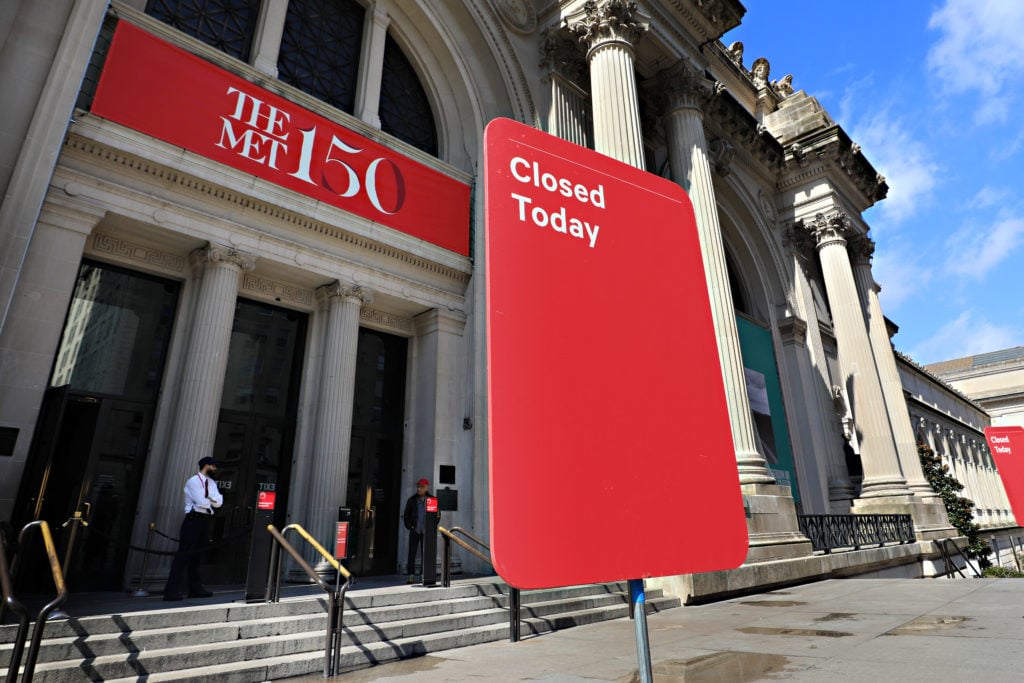
A sign outside the Metropolitan Museum of Art on March 13, 2020. Photo by Cindy Ord/Getty Images.
In the US, museums are losing an estimated $33 million a day as a result of coronavirus, according to the American Alliance of Museums, which last week asked Congress for $4 billion to boost the sector. The organization estimates that as many as 30 percent of museums—many of which are in small and rural communities—will remain closed permanently without federal aid.
“This is the biggest challenge we have faced since the war,” says Hartwig Fischer, the director of the British Museum in London. Speaking for his peers across the UK and echoing museum leaders around the world, Fisher noted that although spending on emergency healthcare should be the top priority, it is “absolutely crucial that the government is behind us, backs us, and helps us to go through this.”
But while the UK and Germany have already pledged hefty sums to support the culture industry, the US has lagged behind—and layoffs have already begun.
On Tuesday, the Museum of Contemporary Art in Los Angeles let go of almost 100 part-time workers, including gallery attendants and educators, equivalent to more than half its workforce. Meanwhile, the Carnegie Museums of Pittsburgh furloughed around half its 1,000-person staff, implemented pay cuts for the remaining workers, and withdrew $1.5 million from its investment fund.
Some believe the crisis will accelerate trends that have been putting strain on the sector for some time, including a winner-takes-all dynamic in fundraising that benefits only the biggest institutions. “There is consolidation we have been seeing for a decade in the museum field,” says Tim Griffin, the director and chief curator of the Kitchen in New York. “This could easily be the thing that pushes it over the edge.”
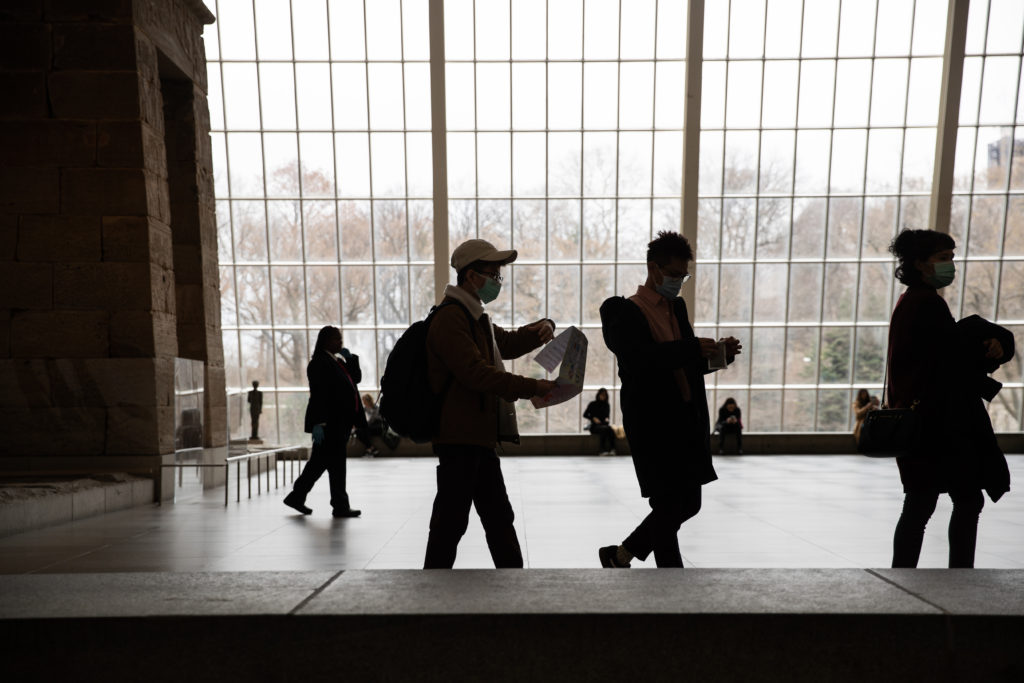
Tourists wearing protective masks at the Met. Photo by Jeenah Moon/Getty Images.
Two weeks ago the world changed drastically for museums.
After the Met announced its plan to close to the public on March 12, institutions across the country shuttered in rapid succession as local governments raced to restrict public gatherings. In London, the Tate was the first big museum to announce it was closing on March 17. The Royal Academy of Arts shuttered the same day, coming to a “screeching halt,” says its chief executive, Axel Rüger.
Almost overnight, exhibitions around the world that have been years, if not decades, in the making were shuttered or postponed indefinitely. Treasures from museums’ collections were stranded halfway around the world on loan with no scheduled return date.
“The speed of this has been the biggest shock,” says Brooke Davis Anderson, the director of the Pennsylvania Academy of Fine Arts in Philadelphia. “It was a fast decision, and museums are not notoriously swift—this was out of character.”
Since then, museums have shifted from dealing with immediate concerns—like how to close down an institution for an indeterminate period of time with 24 hours’ notice—to longer-term issues. Institutions that rely on income from tickets, restaurant revenue, and event rentals (which experts estimate often comprise around 30 percent of a museum’s income, although this can vary widely) are anticipating a serious cash crunch. Even in Europe, where some level of state funding is the norm, leading institutions such as the Royal Academy in London and the Louisiana Museum of Modern Art in Denmark raise substantial amounts of their income through admission and other earned revenue.
“The majority of organizations don’t have a plan B,” says Zannie Voss, the director of SMU DataArts. According to a 2016 survey she conducted, the median art museum had just 1.5 months’ worth of working capital (or cash in hand), underscoring the potentially catastrophic impact of a two-month closure.
The timing of the pandemic is also particularly tricky because major fundraising events for institutions, especially small ones, are usually held in the spring. April is referred to as “gala season” in the art world.
The Kitchen, for example, usually holds two fundraising events: a gala in the spring and an auction in the fall. But its leadership opted to tweak that schedule for the first time this year, converting its fall auction into a spring exhibition.
“What that meant was all our eggs were in this five-month basket that is suddenly being hit,” Griffin says. He estimated money from these now-postponed events accounted for 20 percent of the institution’s annual operating budget.
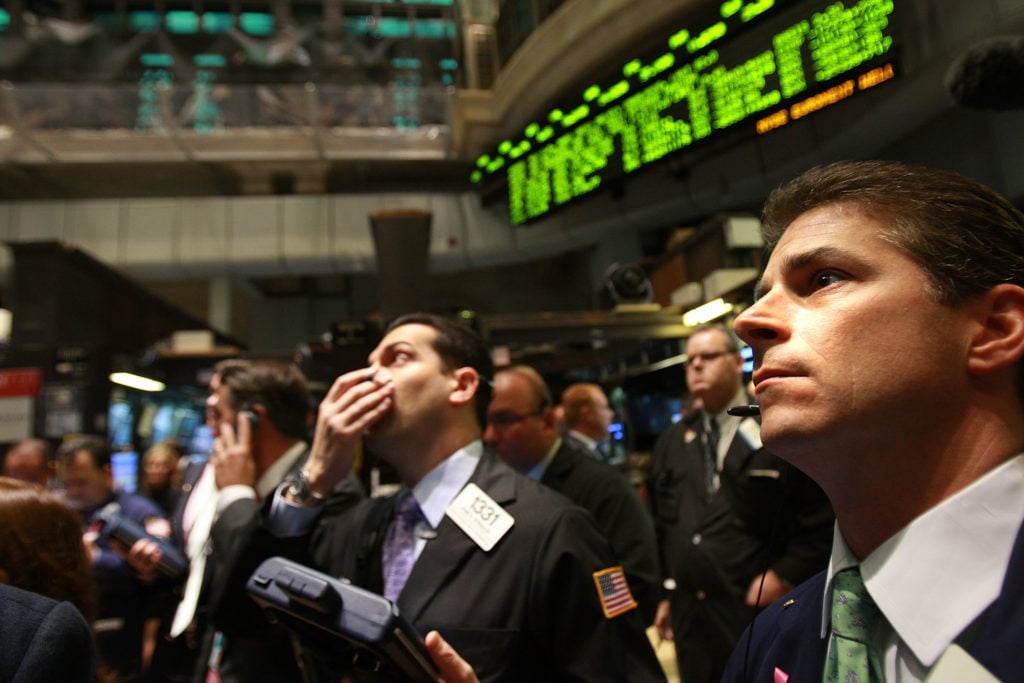
Traders work on the floor of the New York Stock Exchange moments after the opening bell on October 13, 2008. Photo by Spencer Platt/Getty Images.
For many, the unfolding economic crisis brings back painful memories of the 2008 recession, when museums saw the value of their endowments tumble and philanthropic donations shrink, forcing directors and boards to get inventive about how to boost their bottom lines.
During the Great Recession, institutions scrambled to organize benefit auctions, rent their spaces out for special events, reduce the number of exhibitions they mounted each year, and rely more heavily on their collections and less on expensive loan shows. Directors dipped into reserves when necessary, and could always count on some box-office revenue.
“All those cushions and reserves and discretionary spending funds, those have been depleted or redirected for years at many institutions,” says Olga Viso, the former director of the Walker Art Center and a senior advisor at Arizona State University’s Herberger Institute. “That’s how we’ve survived to the present moment.”
And with the fat already trimmed from the bone, Elizabeth Merritt, the director of the AAM’s Center for the Future of Museums, anticipates that this time around will be worse. “The financial collapse was bad, but anyone who had been alive for a while had been through a recession before,” she says. “If it’s been over 100 years since we had our last major pandemic—people don’t have that lived memory and may not have the same confidence.”
It’s the daily staffers who are feeling the pain first. Merritt estimates that a museum’s costs are as much as 75 to 80 percent payroll. This week, the Hammer Museum at UCLA laid off 150 part-time student employees, many of whom staff the reception desk.
“The people working in ancillary and support industries in the museum sector—they are often the people who give an institution its vitality, and the first to be laid off,” says Adrian Ellis, the founder of AEA Consulting.
Museums have taken different approaches to paying their staffs. The Met has committed to paying all its employees only through April 4, while the Walker has committed to paying all staff, including part-time visitor-services associates and gallery guards, through May 31. In London, Tate has pledged to pay everyone until May 1, including those in front-of-house roles. Smaller institutions in the UK are looking to the government’s emergency scheme to pay 80 percent of employees’ pay (up to £28,000 a year) to help them weather the financial crisis.
To unlock money, some museums are asking patrons to relax restrictions on donated funds so they can use them to cover general operations. The director of the Nasher Sculpture Center in Dallas, Jeremy Strick, said one of his longtime donors called him to ask if he was paying his part-time staff during the shutdown—and volunteered to help if that became difficult as time goes on.
But even if social-distancing provisions are lifted in a matter of weeks, which looks increasingly both unwise and unlikely, the aftershocks of the financial hit will be long-lasting. Because of the way museums structure their spending, those that can rely on income from their endowments to get through bumpy periods are unlikely to feel the impact of a stock-market tumble for two to three years.
Viso notes that in the aftermath of the financial crisis, she was able to stave off layoffs for up to two years at the Walker by cutting spending and boosting fundraising. But eventually, the shrunken endowment forced her to cut staff.
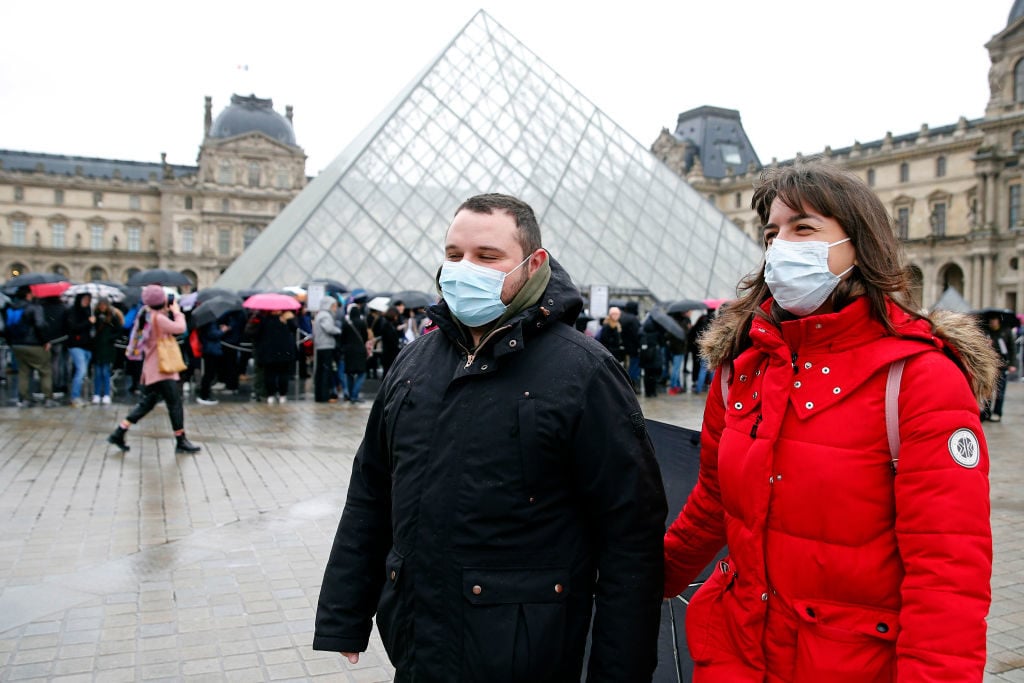
Tourists wearing face masks walk past the Louvre Museum as the museum was closed for a staff meeting about the coronavirus outbreak on March 2. Photo by Chesnot/Getty Images.
With lots of time to think and stew at home, museum leaders are also beginning to fret about a seemingly existential concern: that even after the coronavirus crisis has subsided, people will feel uncomfortable in crowded places.
The Met has already anticipated lower levels of tourism for at least the next year. But the impact may be felt even on museums’ most valued clientele: their dedicated local audience. Having been told by government officials that standing in close proximity to others is a danger to public health, “surely that is going to have some lowering effect on people’s propensity to go gather in social spaces,” Adrian Ellis notes.
That trend would be particularly problematic for museums, which measure success (rightly or wrongly) by attendance—and which have increasingly identified themselves as community hubs rather than cloistered academic institutions.
But others suspect that it is precisely museums’ function as a critical thread in the social fabric that will enable them to make a case for the government and philanthropic funding they need to weather the crisis.
“It’s an opportunity for museums to be saying, ‘We are part of the network and services that will help our communities survive and recover,’” Elizabeth Merritt says. “You may find donors doubling down on arts and culture because it’s an effective mechanism to provide support for social cohesion and education and engagement.”
Regardless of the size and location of their institution, museum leaders around the globe agree that this unprecedented crisis will require them to question assumptions about how their institutions have always worked. Now, they must prepare to make lasting changes.
“Over the past decade, people in art and culture have been looking at how institutions need to be restructured,” Tim Griffin says. “And now everybody’s hand is being forced to rethink those structures to address a really radically changed landscape. We are going to be entering a period of invention.”